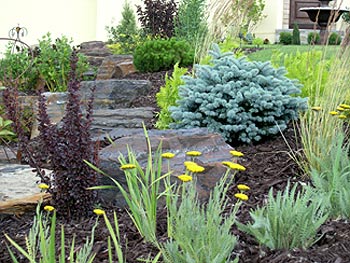RENEGADE GARDENER™
The lone voice of horticultural reason
Deciphering the Sun
2-01-08 — Quick, name a perennial that prefers full sun. Not too tough a question; Achillea, Aster, Baptisia, Chrysanthemum, Clematis, Coreopsis, Lilium, Perovskia, Phlox, Rudbeckia and Veronica are just a few of the perennials that won’t perform well unless this cultural requirement is met.
Now the tough questions: Just what the heck IS full sun? Or part sun, part shade, dappled shade and shade, for that matter? Understanding what is meant by these terms, and recognizing the sunlight conditions throughout your property, is critical to your success at growing healthy, robust perennials.
 |
| 10 hours of direct sun is “full sun” every time. But what about six? |
Arriving at definitions for the various sunlight requirements is to open a Pandora’s box from the start. When reading the plant tag on a perennial, one will usually find it has been placed in one of three categories: full sun, part sun, or shade. Sometimes, “part shade” will be thrown into the mix, as will “light shade” and “full shade,” all adding to the confusion. Are “part sun” and “part shade” the same thing? Are “light shade” and “part shade” equals? What is the difference between “shade” and “full shade?” The fact of the matter is, no true and hard definitions exist, and no two perennial experts will give exactly the same answer. Here are my definitions of the various sunlight requirement categories, which are as good as any:
Full Sun — Start from the absolute: A patch of yard that receives direct sunlight from sunrise to sundown is full sun, every time. Now, how many hours of sunlight can we knock off and still call it full sun? A generally accepted definition of full sun is six or more hours of direct sunlight per day. But here’s where gardeners need to understand the one factor that is rarely mentioned: time of day that the sunlight is hitting the perennial.
Midday sunlight, when the sun is high overhead, is more powerful than early morning or late afternoon/early evening sunlight. In my book, a spot in your yard that receives direct sunlight from 2:00 p.m. to sunset—just over six hours— is not full sun, and perennials such as Achillea and many rose varieties are going to struggle and present meager bloom. But if those six hours fall somewhere around 10:00 a.m. to 4:00 p.m., virtually all full sun perennials will be as happy as can be.
Understand that there are four key hours in the full sun equation, 11:00 a.m. to 3:00 p.m. (give or take a half-hour on either side). That’s when the sun is supremely potent. If a perennial catches most or all of these four hours, and then, due to a tree canopy or their proximity to the house, they’ve also nabbed an hour or so of sun just after sunrise, or they pick up another couple of hours late in the day, hey, call it full sun. My front yard happens to receive only these four, peak midday hours of sunlight, with light dappled shade the rest of the day, and I’d say that eighty percent of the full sun perennials I’ve tried perform from adequately to very well.
Part Sun — If a perennial is said to prefer part sun, it means that six hours or more of direct sunlight that includes high, midday sun is too much and will cause the plant to struggle and perhaps the leaves to burn. The classic part sun scenario is a patch of garden that receives about four to five hours of morning sun, then shade the rest of the day, or shade in the morning and four to five hours of sun in the afternoon. Avoidance of at least three of the four aforementioned, peak hours of midday sunlight is often necessary.
Part Shade — You don’t see this one a lot, but if you do, consider it the same as Part Sun above, and you’ll usually be fine. If the perennial fails to grow well, however, particularly showing foliage problems, you should move the plant to an area that receives about an hour less direct sun.
Remember that shade is sunlight that is not direct. Even in the various degrees of shade, if the sun is in the sky, its rays are always hitting the plant’s leaves; they’re just weakened. If there weren’t some degree of sunlight around there somewhere, you’d be stumbling around in the total dark. Shade caused by a building is a heavier filter of the sun’s rays than all but the thickest tree canopy. So when factoring shade, you must consider both hours of direct sunlight and hours of filtered sun, and learn which plants handle what. Most “part shade” plants will do very well in a spot that receives NO direct sunlight, but higher intensity, filtered sunlight throughout the day.
Dappled Shade — This is sometimes also described as light shade, and means shade created by the filtering of the sun through a tree canopy. Periods and patches of direct sun may be present throughout the day, but of the fifteen- or twenty-minute-at-a-time variety. Toss in a few hours of direct sunlight anywhere, and I call it Light Shade.
Shade — Shade by high tree canopies that pretty much knock out the brief moments of direct sun.
Full Shade — Shade caused by buildings, very dense or low tree canopies, in which not only is there no direct sunlight, the area is noticeably dark during the day.
Perfect definitions? Of course not. But they’re as close as anyone else’s.
Don Engebretson
The Renegade Gardener